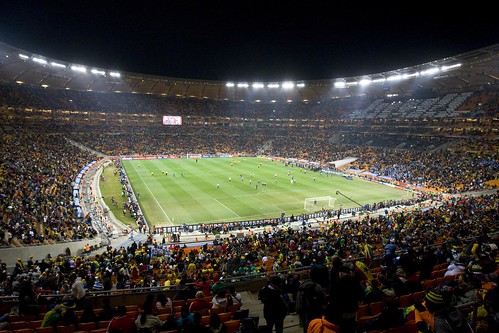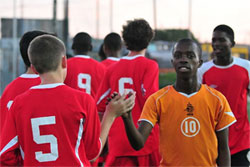
The World Cup: Baghana Baghana
-

- World Cup quarterfinals, Ghana vs. Uruguay, Soccer City Stadium, Johannesburg. (Steve Evans / CC)
I was eating traditional African cuisine with a group of South Africans at a Melrose Arch, Jozi restaurant during the Ghana-Uruguay quarterfinals. The South Africans were pulling hard for Ghana’s Black Stars to advance to the semifinals since that would be a first for an African team. A week ago, Ghana had handily knocked out Team USA at Rustenburg’s Royal Bafokeng Stadium to make it to the quarters, so I decided to support “Baghana Baghana,” too.
After the match began, we waved our miniature Ghanan flags in between rich little bites of springbok, caramelized biltong and mielie-meal pap. “Ghana, make Africa proud!” one fan shouted at a table next to us. During additional time at the end of the first half, Ghana did just that. Its 25-year-old midfielder, Sulley Muntari, caught Uruguay’s keeper on the wrong foot and curled the ball into the right side of the net. “Beautiful goal,” mused an attractive woman with dreadlocks down to her waist. “Unstoppable,” our table agreed, as Muntari’s goal was replayed again and again on TV.
Then, at the beginning of the second half, Uruguay scored, making it 1-1. We took the goal in stride, and gulped our drinks while the opposing team’s blue-and-white striped fans chanted “olé olé olé!” at the stadium. Before we knew it, the match had moved into an extra half hour of time. Suddenly, Ghana’s striker, Dominic Adiyiah, headed a ball towards the goal just moments before overtime was up. Uruguay’s striker, Luis Suárez, who was standing on the goal line, countered by blocking Adiyiah’s header with his arm. The ref gave Suárez a red card for the handball and tossed him out of the match. “Boo!” someone shouted. The restaurant came alive as Ghana’s #3, Asamoah Gyan, prepared to take the free kick. The stakes were high; if the team’s top scorer made the goal, the Black Stars could advance to the semifinals. If not, the teams would have to settle the tie in a dangerous penalty shoot-out. Much to our dismay, Gyan’s shot missed, bouncing off the bar at the top of the goal. Uruguay subsequently proved better than Ghana in the penalty kicks that followed, and won the shoot-off, 4-2. The West African team—and Africa—was out of the World Cup.
Our table was devastated at the match’s outcome. “One scotch on the rocks,” called out a crushed fan. “Shame that Ghana lost. This was for Africa!” a Jozi filmmaker at the table added. “But Ghana is the better team though, isn’t it?” another insisted. The next day, we tried to come up with reasons why the Black Stars had missed not one, but three penalty kicks during the match. Nerves? Inexperience? A lack of resources at the professional level?
The whole thing got me thinking about a conversation I had in Cape Town earlier that week with Coaching for Hope, an NGO building Africa’s soccer squad from the ground up.
“We train coaches from marginalized communities. . .who can’t afford to access South African training,” one of the group’s coordinators, Norman Brook, told me.
-

- Charlotte United Under 16 Football Club, at the end of a game against a local football team at the Chris Carter Soccer Field in Khayelitsha. The North Carolina team was on a tour organized by AMsportstours.
Coaching for Hope, which was created by UK charity Skillshare International, sends football pros like David Beckham, the famous English footballer married to Victoria “Posh Spice” Adams, to townships to teach basic coaching skills to ordinary players. Then the NGO helps the new coaches set up their own youth soccer teams in West and Southern Africa. Roma Traaore, a native of Burkina Faso, says he has benefited from the program. “I will teach them [children] to love the game, to play with joy and to learn fair play,” reads one of Traaore’s quotes on Coaching for Hope’s website. “My passion is to help children in my country play football.”
But even though it’s investing big in Africa’s soccer players, Coaching for Hope says it’s not focused on making the continent’s national teams the best in the world. “No doubt talent will amount from that, but we don’t view that as our job. We’re enabling them to coach and empowering them to address social issues like HIV/AIDS.” Brook says they’re doing that by combining lessons about substance abuse, women’s empowerment and HIV/AIDS prevention with soccer practice on the field. There are more than 22 million people living with HIV in sub-Saharan Africa. That’s two thirds of the total HIV/AIDS population worldwide.
Although Coaching for Hope says there’s still plenty of work to do, it reports it has been able to get 700 coaches and 30,000 African children trained and playing football on the pitch. That’s something to watch out for at the 2014 World Cup.
